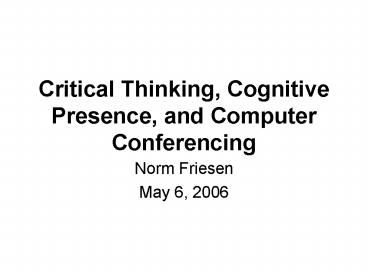Critical Thinking, Cognitive Presence, and Computer Conferencing PowerPoint PPT Presentation
1 / 22
Title: Critical Thinking, Cognitive Presence, and Computer Conferencing
1
Critical Thinking, Cognitive Presence, and
Computer Conferencing
- Norm Friesen
- May 6, 2006
2
Terms Concepts
- Critical community of Inquiry group engaging
collaboratively in practical inquiry usually
includes a teacher - Cognitive presence the construction and
confirmation meaning through sustained reflection
and discourse in a critical community of inquiry - Cognitive Presence Critical inquiry
3
Practical Inquiry Model
4
Practical Inquiry
- Two Dimensions
- continuum between action and deliberation
- transition between concrete and abstract worlds
cognitive processes that associate facts and
ideas
5
Four Phases (1 through 3)
- Triggering Event an issue, dilemma, or problem
that emerges from experience is identified or
recognized. - Exploration participants shift between the
private, reflective world of the individual and
the social exploration of ideas - Integration characterized by constructing
meaning from the ideas generated in the
exploratory phase reflection ?? discourse
6
Four Phases (4th)
- Resolution
- testing the hypothesis by means of practical
application - a vicarious test using thought experiments and
consensus building within the community
7
(No Transcript)
8
Critical Inquiry and CMC
- The CMC transcript is valuable in that it
provides an accurate record of nearly all the
dialogue and interaction that took place - There is no body language or paralinguistic
communication
9
Triggering Events
- Asking questions
- Background info that culminates in a question
- Messages that take discussion in a new direction
10
Exploration
- Personal narratives/descriptions/facts
- Divergence within community or within a message
- Unsubstantiated contradiction of previous ideas
- many themes in one message
- unsupported opinions
11
Integration
- Agreement within community or within a single
message - Integrating information from various sources
- Justified yet tentative hypotheses
12
Resolution
- Vicarious application to real world
- Testing solutions
13
Study of 24 messages 1 week
14
Conclusion
- We believe such an approach is capable of
refining the concept and model presented here to
the point where it can be a reliable and useful
instructional tool for realizing higher-order
educational outcomes.
15
Excursus on Content Analysis
- This is an example of content analysis
- a standard methodology in the social sciences for
studying the content of communication - objectively and systematically identifying
specified characteristics of messages. - Describe and make inferences about the character
of communications
16
Word counting
- Early and simple version is to count word
occurrences - KWIC and KWOC indexes developed for this purpose
- Zipf's law words and phrases mentioned most
often reflect the most important concerns - "Primitive" version of this using Google
- The issue of inference arises
17
Other approaches
- Coding frames used identify concerns, infer
concerns, themes, processes, etc. from text and
label them - For example Global Warming coverage
- Types of guests or "experts" in news shows
- In what contexts it is mentioned? Science,
lifestyle, Economics, national/international
politics - Other examples? (e.g. "issues, qualifications,
horse race, and hoopla)
18
Issues and Problems
- inter-coder reliability and intra-coder
reliability - Is a coder or group of coders consistent across
time? - Is a coder consistent with other coders?
- Process of inference
- "Television is the primary source of presidential
election information for the majority of
Americans" (Graber 1993 Hernandez 1997) - Discussion topics and themes reflect actual group
or mental processes
19
Rourke (2005)
- I analyzed the messages and the interview
transcripts using qualitative content analysis
techniques associated with grounded theory, and I
employed measures to promote trustworthiness
associated with naturalistic research. - 15 weeks, 67 weeklong conferences for small groups
20
Potential Problem
- There may be a variety of technical, access, or
deeper social, psychological, and educational
inhibitors to participation in the conference,
which means that the transcript of the conference
is a significantly less-than-complete record of
the learning that has taken place within the
community of inquiry.
21
Findings
- Their activities included
- providing others with praise and encouragement,
- presenting informal arguments,
- engaging in discursive explorations
- making connections between course topics and
their personal experiences
22
Rourke, Findings, cont
- Contrary to constructions of this technology in
our literature, the students did not approach the
conferences as forums for critical discourse or
collaborative meaning making.

